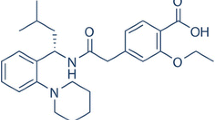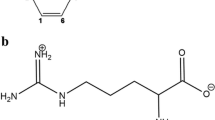Abstract
The purpose of the work is physicochemical characterization of nimesulide (NI) and meloxicam (ME)–hydroxypropyl-β-cyclodextrin (HP-β-CD) binary systems both in solution and solid states and to improve the pharmaceutical properties of NI and ME via inclusion complexation with HP-β-CD. Binary systems of NI and ME with HP-β-CD have been characterized both in solution and solid state by different physicochemical methods. Three types of drug–HP-β-CD binary systems, namely physical mixtures (PM), kneaded systems (KS) and co evaporated systems (CS) in 1:1 and 1:2 molar ratios (1:1 and 1:2 M) were prepared. Phase solubility and 1H-NMR spectroscopic studies in solution state revealed 1:1 M complexation of NI and ME with HP-β-CD. A partial inclusion of NI with HP-β-CD at both molar ratios of kneaded and co evaporated systems and a true inclusion of ME with HP-β-CD at both molar ratios of co evaporated systems in solid state was confirmed by differential scanning calorimetry (DSC), powder X-ray diffractometry (powder X-RD) and scanning electron microscopy (SEM) studies. Dissolution properties of NI and ME–HP-β-CD binary systems were superior when compared to corresponding pure drugs. The aqueous solubility and dissolution properties of NI and ME can be improved by inclusion complexation with HP-β-CD.
Similar content being viewed by others
References
N. Davis R.N. Brogden (1994) Drugs 48 431 Occurrence Handle7527762
M. Distel C. Mueller E. Bluhmki (1996) Inflammo. Pharmacol. 4 71
D. Truck U. Busch G. Heinzel H. Narjes (1997) Drug Res. 47 253
D. Duchene D. Wouessidjewe (1990) Drug Dev. Ind. Pharm. 16 2487
O. Bekers E.V. Uijtendal J.H. Beijnen A. Bult W.J. Underberg (1991) Drug Dev. Ind. Pharm. 17 1503
V.J. Stella R.A. Rajewski (1997) Pharm.Res. 14 556 Occurrence Handle10.1023/A:1012136608249 Occurrence Handle9165524
G. Tsoucaris. In D. Duchene (ed.), Cyclodextrins and Their Industrial Uses, Editions De Sante, Paris (1987), pp. 19
T. Higuchi K.A. Connors (1965) Phase solubility techniques C.N. Reilly (Eds) Advances in Analytical Chemistry Instrumentation EditionNumber4 Interscience New York 117–212
K.A. Khan (1975) J. Pharm. Pharmacol 27 48 Occurrence Handle235616
O.I. Corrigan T. Stanley (1982) J. Pharm. Pharmacol. 34 621 Occurrence Handle6128383
Author information
Authors and Affiliations
Corresponding author
Additional information
Author for correspondence: E-mail: nbnaid2@E-mail.uky.edu
Rights and permissions
About this article
Cite this article
Nalluri, B.N., Chowdary, K., Murthy, K. et al. Inclusion Complexation and Dissolution Properties of Nimesulide and Meloxicam–hydroxypropyl-β-cyclodextrin Binary Systems. J Incl Phenom Macrocycl Chem 53, 103–110 (2005). https://doi.org/10.1007/s10847-005-1676-9
Received:
Accepted:
Issue Date:
DOI: https://doi.org/10.1007/s10847-005-1676-9




